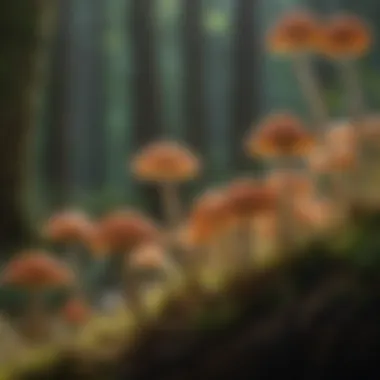Understanding Mushroom Spores: A Cultivation Guide


Intro
The cultivation of edible mushrooms relies heavily on an understanding of spores, which play a crucial role in their reproduction and growth. By grasping the biology behind spores and the methods for their cultivation, enthusiasts and practitioners can enhance their mushroom growing endeavors. This guide aims to illuminate the various aspects of spores, from their significance to practical techniques for successful cultivation, enabling practitioners to achieve their goals effectively.
Understanding Forestry Practices
In the context of mushroom cultivation, understanding forestry practices is fundamental to promoting sustainable growth environments for edible mushrooms. Being aware of how forest ecosystems operate contributes to optimal spore development and ultimately to healthier mushroom crops.
Types of Forestry Practices
Different forestry practices influence the availability of substrates necessary for mushroom cultivation. Key practices include:
- Selective Logging: This method allows for the careful removal of certain trees, which helps in maintaining a balanced ecosystem that can support fungal growth.
- Agroforestry: By integrating trees and shrubs into agroecosystems, practitioners can create favorable conditions for mushroom spores to thrive, while simultaneously improving soil health.
- Reforestation: Planting and nurturing new forests also aids in creating habitats for mushrooms to develop, thereby supporting spore dispersal.
Historical Context
Mushroom cultivation has a rich history that intertwines with forestry practices. Traditionally, mushrooms have been gathered in forests, where natural conditions provided a suitable environment for spores to germinate. Understanding these historical practices can provide insights into the best methodologies for modern cultivation. Many cultural traditions highlight specific fungi, which reveal the relationship between people and their natural environments.
Principles of Woodland Stewardship
Woodland stewardship principles ensure that forestry practices support not only mushroom cultivation but also biodiversity and ecosystem health. Effective management of forest resources is key to long-term sustainability.
Conservation Techniques
Employing conservation techniques is essential for protecting both the forest and the mushroom species it supports:
- Soil Conservation: Maintaining soil structure serves to enhance moisture retention, a critical factor in spore germination.
- Biodiversity Promotion: By fostering diverse species, practitioners can ensure a stable ecosystem that enhances spore viability and growth potential.
Managing Forest Resources
Practicing responsible management of forest resources directly influences mushroom production. Techniques such as monitoring species population and controlling invasive species may help maintain an environment conducive to both forestry and mushroom growth. This dual approach promotes healthier forests and yields better mushroom harvests.
Sustainable Forest Management
Sustainable forest management principles are essential to preserving ecosystems while supporting economic activities such as mushroom cultivation. By adhering to these principles, practitioners can cultivate mushrooms responsibly without compromising the integrity of the surrounding environment.
Certification Standards
Several certification standards exist to ensure sustainable practices, which include:
- FSC (Forest Stewardship Council): Indicates that products are sourced from responsibly managed forests.
- PEFC (Programme for the Endorsement of Forest Certification): Aims to ensure sustainable forest management through independent third-party certification.
Economic Benefits of Sustainability
Adopting sustainable practices yields not only environmental benefits but also economic advantages. Sustainable forestry can reduce costs associated with resource depletion and promote new revenue streams through mushroom cultivation. Additionally, sustainably grown mushrooms often garner higher market prices, thus improving profitability.
"Investing in sustainable practices is not just an ecological necessity; it's also an economic opportunity that deserves attention."
Preface to Mushroom Spores
Mushroom spores are crucial for the cultivation and growth of edible mushrooms. Without understanding spores, enthusiasts and practitioners may struggle to achieve successful outcomes in their mushroom cultivation efforts. This section provides a foundational overview of what spores are and how they function within the life cycle of fungi. Additionally, we will explore the various types of spores found in edible mushrooms, emphasizing the significance of this knowledge for effective cultivation practices.
Definition of Spores
Spores can be defined as microscopic reproductive units of fungi. They play a vital role in the propagation and survival of mushroom species. Spores are produced in great numbers, ensuring the continuation of the species under favorable conditions. Upon landing in a suitable environment, some spores can germinate and develop into new fungi. These structures differ greatly in morphology and function, as they adapt to diverse environments and reproductive strategies.
The Role of Spores in Fungi Life Cycle
In the fungi life cycle, spores are not just passive entities but vital players in reproduction. They facilitate both sexual and asexual reproduction depending on the species. When conditions are favorable, spores may germinate into mycelium, a network of hyphae that absorbs nutrients from the substrate. This process is essential, as it leads to the formation of mushrooms, the fruiting bodies we aim to cultivate.
Interestingly, some spores remain dormant until conditions improve, ensuring the survival of the species through adverse climates or circumstances. Understanding this aspect of spores is critical for growers wishing to optimize their cultivation strategies.
Types of Spores Found in Edible Mushrooms


Numerous types of spores exist in the realm of fungi, each with distinct characteristics. The types of spores commonly identified in edible mushrooms include:
- Basidiospores: Associated with most edible mushrooms, these spores are produced on basidia, specialized cells on the fruiting body.
- Ascospores: Found in certain species of edible fungi, ascospores develop within an ascus, another type of reproductive cell.
- Chlamydospores: These spores are thick-walled and serve as a survival mechanism, remaining viable for extended periods.
Understanding these distinctions is beneficial for cultivation, as specific spores can affect growth rates, resistance to diseases, and overall yield.
Biology of Mushroom Spores
Mushroom spores are fundamental to the life cycle of mushrooms and the study of their biology provides critical insights for both enthusiasts and practitioners. Understanding the biology of these spores not only enhances the cultivation process but also contributes to the overall health and sustainability of mushroom farming. Knowledge of spore structure, viability, and genetic diversity is key for optimizing cultivation techniques. These elements can lead to improved yields and better quality mushrooms.
Spore Structure and Composition
Mushroom spores are microscopic entities that serve as the reproductive units for fungi. Their structure is highly specialized to ensure success in dispersal and survival. Spores typically consist of a protective outer layer known as the exosporium, which is essential for resisting environmental stress. This outer layer is often thicker in species that inhabit harsher conditions, allowing them to withstand desiccation, temperature fluctuations, and microbial attack.
Inside the exosporium lies the cytoplasm, which contains the nucleus and various organelles necessary for the spore's metabolism and eventual development into a mushroom. The composition of spores includes carbohydrates, proteins, and lipids, which contribute to their energy storage and structural integrity.
The resilience and adaptability of spores come from their biochemical makeup, making them pivotal in the propagation of edible mushrooms.
Spore Viability and Longevity
Viability refers to the ability of a spore to germinate and develop under favorable conditions. Factors affecting spore viability include moisture, temperature, and light. Generally, most spores can remain dormant for extended periods, sometimes many years. Research indicates that under optimal storage conditions, edible mushroom spores like those of Agaricus bisporus can retain 70% viability for several years.
Longevity varies by species. For instance, Pleurotus ostreatus spores have been noted to have shorter viable periods compared to Ganoderma lucidum. Understanding these variances is important for mushroom cultivation, particularly in planning sowing times that align with spore viability.
Genetic Diversity in Spores
Genetic diversity within mushroom spores is another significant aspect to consider. This diversity arises from sexual reproduction, where spores from different mating types combine genetic material. This process results in offspring that possess a mix of traits from both parent fungi, contributing to greater resilience against pathogens and environmental stresses.
Preserving genetic diversity in spore stocks can also lead to improved cultivars with enhanced growth rates or better nutritional profiles. Cultivators sometimes utilize mycelial crossings or hybridization techniques to encourage the production of diverse and stronger strains. Maintaining a diverse spore lot can be a strategic move to minimize risks associated with monocultures.
Cultivation of Edible Mushroom Spores
Cultivating edible mushroom spores represents a crucial area for enthusiasts and practitioners venturing into advanced mushroom cultivation. The growing interest in home cultivation and foraging has led many to explore methods for growing mushrooms from spores, making understanding the intricacies of spore cultivation more significant. Proper spore cultivation leads to healthier yields, allowing cultivators to enjoy both the process and the results of their labor.
The benefits of successful spore cultivation include increased genetic diversity, which can contribute to greater resilience against disease and pests. Selecting appropriate spore types is essential not only for improving yield but also for tailoring cultivars to specific environmental conditions. This cultivation process involves selecting quality spores, efficient inoculation, and the appropriate growth media to support healthy mycelium development.
Spore Selection: Key Factors to Consider
Selecting the right spores is a foundational step in successful mushroom cultivation. Various factors come into play:
- Species and Strain: Different species have unique growth patterns and requirements. Popular species include Agaricus bisporus, Pleurotus ostreatus, and Lentinula edodes. Make sure to choose a strain suited to the growing conditions you can control, such as temperature and humidity.
- Genetic Quality: Assess the spore source for vitality and genetic stability. Ideally, spores should come from reputable suppliers. This aids in obtaining vigorous and healthy mushrooms.
- Spore Composition: Focusing on the spore morphology and structure can provide insights into expected growth behaviors. Understanding the spore's biology helps in selecting the right candidates for cultivation.
The selection process requires careful consideration, as poor choices can lead to weak growth or contamination issues.
Methods of Spore Inoculation
Once the right spores have been selected, the next step is to inoculate the growth medium effectively. A few methods are commonly used:
- Direct Spore Inoculation: This method involves sprinkling spores directly onto the substrate. This can be practical in small-scale operations or when experimenting with new strains.
- Liquid Culture Method: This involves growing spores in a nutrient-rich liquid medium. This technique allows for easier inoculating across a larger volume of substrate and can increase the likelihood of successful colonization.
- Spawn Inoculation: Using pre-colonized grain or sawdust spawn is another effective technique. This method ensures that mycelium is already vigorous, providing a competitive advantage against contaminants.
Successful inoculation techniques lead to rapid colonization of the substrate, minimizing the risk of contamination during the crucial early stages of growth.
Media for Culturing Spores
Choosing the right media is vital for supporting the life cycle of the mushroom spores. The media must provide nutrients, moisture, and a supportive environment for growth. Common media options include:
- Grain: A popular choice for spawning. Grain offers a rich nutrient profile, supporting aggressive mycelial growth.
- Agar Plates: Useful for isolating and culturing specific strains. Agar allows for easy observation of growth patterns.
- Synthetic Nutrient Solutions: These can provide a controlled environment and reduce variability in nutrient availability.
It is crucial to sterilize the media before inoculation to eliminate competitors and pathogens. Proper sterilization methods are necessary to ensure a successful growing environment.
Environmental Conditions for Spores Growth
Understanding the environmental conditions necessary for the growth of spores is essential in mushroom cultivation. Spores are highly sensitive to their surroundings, and the right balance of temperature, humidity, and light will significantly influence their germination and subsequent growth. Each of these factors can either promote or hinder the successful cultivation of edible mushrooms.
Temperature Requirements


Temperature is a critical factor in the growth of mushroom spores. Spores generally have a specific range of temperatures that they thrive in, and exceeding or falling below this range can inhibit their development. Most edible mushroom species prefer temperatures between 20°C to 24°C.
- Optimal Growth: At this range, spores can germinate effectively, allowing for vigorous growth of mycelium—the vegetative part of fungi.
- Cold Conditions: Lower temperatures can lead to dormancy in spores. For instance, some varieties may require chilling periods to stimulate growth.
- Heat Concerns: On the other hand, excessively high temperatures can cause spore death or impair their viability.
Maintaining a stable temperature environment can be achieved using incubators or temperature-controlled growing areas. Monitoring tools that provide real-time feedback are valuable for ensuring consistency.
Humidity Control
Humidity plays a crucial role in the success of spore cultivation. The humidity levels must be managed accurately to create a beneficial environment for mycelial growth and mushroom development. High humidity can facilitate spore germination, while low humidity can lead to desiccation of spores and failed growth.
- Ideal Levels: Generally, a relative humidity of 80% to 90% is suitable for most edible mushroom species during the initial growth stages.
- Monitoring and Adjustments: Humidity can be regulated using humidifiers, misters, or by adjusting ventilation.
- Condensation Issues: However, care must be taken to avoid excessive moisture that can lead to condensation, which may promote the growth of unwanted bacteria or molds.
As a best practice, it is essential to regularly assess humidity levels and make adjustments as needed. Implementing hygrometers in your growing environment can provide reliable readings.
Light Exposure Considerations
Light exposure is often overlooked in spore cultivation, yet it is vital for the differentiation of specific mushroom species and their fruiting processes. Different mushrooms require varying light conditions.
- Photo-Period Sensitivity: Some mushrooms need complete darkness to germinate, while others benefit from indirect light to initiate fruiting.
- Quality of Light: The intensity and spectrum of light can affect growth rates and morphology. For instance, blue light is often recommended during the fruiting phase to encourage development.
- Overexposure Risks: Too much light can harm the delicate spores and can induce evaporation, affecting humidity levels.
In summary, understanding and maintaining the right environmental conditions for spores growth is key. Proper temperature management, humidity control, and light exposure are all critical to successful mushroom cultivation.
"The success of mushroom growing relies as much on environmental conditions as on the quality of spores used. Striking the right balance is essential for optimal results."
By focusing on these foundational elements, enthusiasts and professionals can enhance the efficiency of their cultivation processes.
Advanced Techniques in Spore Cultivation
Advanced techniques in spore cultivation enhance the ability to grow high-quality edible mushrooms. These methods maximize efficiency, reduce common issues, and expand the range of edible fungi available to cultivators. By understanding particular strategies and their benefits, enthusiasts and practitioners can optimize their growing processes.
Cloning from Spores
Cloning is a significant method that provides a pathway for duplicating desirable mushroom traits. When a spore germinates, it can grow into mycelium, a structure that feeds on nutrients and can be cultured further. This technique allows for the preservation of a certain genetic profile, ensuring that the characteristics of the original mushroom can be replicated reliably.
Key benefits of cloning include:
- Genetic Consistency: Growers can ensure that the offspring will maintain the desired traits, such as yield and flavor.
- Disease Resistance: Selecting spores from robust fruiting bodies can lead to future crops with better resilience against infections.
- Microenvironment Control: Cultivating spores in a controlled setting can lead to stable and repeatable results, advantageous for commercial purposes.
Using Spawn for Effective Cultivation
Spawn serves as a vital component in mushroom cultivation. It is essentially starter material that contains mycelium, the vegetative part of the fungus. Using high-quality spawn can significantly increase the chances of successful cultivation. This method minimizes the time taken between spore inoculation and mushroom growth, ensuring a quicker turnover.
Considerations when utilizing spawn include:
- Quality of Spawn: Always source from reputable suppliers. High-quality spawn leads to better outcomes.
- Spawn Type: Different mushroom species require different types of spawn. Knowing what to select is crucial.
- Inoculation Techniques: Effective methods must be employed during the inoculation phase to ensure successful uptake by the substrate.
Sterile Techniques in Spore Handling
Maintaining sterility throughout the spore cultivation process cannot be overstated. Contaminants can easily undermine the entire growth cycle. As such, practicing sterile techniques is essential for achieving successful mushroom crops.
Effective sterile practices include:
- Clean Workspace: Ensure surfaces and tools are disinfected before starting any spore handling.
- Use of Gloves and Masks: Protect the spores from contamination from hand oils and airborne pathogens by using gloves and masks during procedures.
- Aseptic Transfer Methods: Employ techniques such as working in a laminar flow hood or utilizing alcohol lamps to create a sterile environment.
"Sterility is the backbone of successful mushroom cultivation, as contaminants can ruin the results of even the best techniques."
Challenges in Spore Cultivation
Spore cultivation presents various challenges that enthusiasts and practitioners must understand. The successful growth of edible mushrooms relies heavily on effective spore management. Addressing these challenges is vital not just for increasing yield but also for ensuring the health and quality of the mushroom crop. Awareness of potential pitfalls allows cultivators to implement strategies that mitigate risks and optimize outcomes.
Contamination Risks
One of the foremost challenges in spore cultivation is contamination. Fungi, like any living organism, exist in diverse environments, many of which can harbor unwanted pathogens. Contaminants can include bacteria, mold, or wild fungi that compete for resources. This competition can adversely affect the intended mushroom growth and yield.
To minimize the risks associated with contamination, it is essential to:


- Maintain sterile conditions during spore inoculation and transfer.
- Utilize hygiene practices, such as wearing gloves and disinfecting surfaces.
- Use pressure cooking for media sterilization, which significantly reduces the presence of any pathogens.
Ensuring these practices are followed can drastically lower contamination rates in spore cultivation setups.
Spore Dormancy and Activation
Spore dormancy is another significant challenge for cultivators. Many spores can remain viable for long durations, displaying a dormant state that prevents germination. Properly activating spores is crucial for successful cultivation. This requires the right balance of conditions, including temperature and moisture.
Some core points regarding spore dormancy include:
- Understanding when to activate spores is essential. Not all spores become active simultaneously, and mistiming activation can lead to poor growth rates.
- Temperature fluctuations during storage can affect spore viability. Keeping spores in a stable environment enhances their active state when needed.
Cultivators must be knowledgeable about spore behavior to optimize activation and grow robust mushroom crops.
Pest Management Strategies
Managing pests is an unavoidable aspect of spore cultivation. Pests can harm both the substrates used for growth and the developing mushrooms themselves. Common pests include insects like flies and mites, which can target vulnerable growth areas.
Implementing effective pest management strategies involves:
- Routine inspections of mushroom growing areas to identify pest activities early.
- Introducing biological controls, such as beneficial insects that prey on harmful pests.
- Utilizing traps to monitor and minimize pest populations without resorting to harmful chemicals.
Cultivators must be proactive to prevent pest outbreaks that can jeopardize the entire cultivation process.
Harvesting and Storing Spores
Harvesting and storing spores is a critical aspect of mushroom cultivation, particularly for those focused on edibles. Proper methods can prolong the viability of spores and ensure successful cultivation. In this section, we will discuss best practices related to timing, techniques for collection, and how to store spores effectively.
Timing the Harvest
Timely harvesting of spores plays a vital role in the cultivation process. It is crucial to choose the right moment to collect spores, as this can greatly impact their viability. Spores are typically ready for collection when the caps of the mushrooms have fully expanded and the veil has torn. This is when the highest number of mature spores will be present.
Indicators of readiness include:
- The color of the spore print, which can vary greatly among species.
- The state of the gills or pores beneath the cap, which should expose mature spores.
Harvesting too early may yield immature spores, which are less viable. Conversely, waiting too long can lead to over-dispersion, as mature spores will be released into the air. Uniformity in collection is essential for consistent outcomes in future cultivation efforts.
Methods of Spore Collection
Effective spore collection methods ensure a high yield from a few mushrooms. One common method is utilizing a spore print. Here’s how to do it:
- Prepare a clean surface. Non-contaminated materials such as glass or paper are best.
- Remove the stem. Cut the mushroom at the base, leaving the cap intact.
- Place the cap. Position the mushroom cap gill-side down on the surface for several hours or overnight.
- Collect the spores. After the time has passed, carefully lift the cap to reveal the spore print.
Other methods include using sterile cotton swabs to collect spores directly from the gills or utilizing spore syringes for a more liquid-form approach. Maintaining freshness during collection is crucial; contaminants can reduce spore viability and lead to poor cultivation results.
Storage Conditions for Spores
Once harvested, storing spores under appropriate conditions is necessary to maintain their viability. Consider the following points:
- Temperature: Store spores in a cool, dry environment. A temperature range of 0°C to 4°C is generally recommended.
- Humidity: Excess moisture can encourage spore germination or mold growth, rendering them useless. Keep humidity low during storage.
- Containers: Use airtight containers made from glass or high-density polyethylene to avoid exposure to moisture and air.
Proper storage not only maintains viability but also ensures that spores remain uncontaminated for future use.
The End and Future Directions
In the realm of edible mushroom cultivation, understanding spores is pivotal. This article highlights core aspects of spore biology, cultivation, and harvesting techniques that are essential for both practitioners and enthusiasts. The conclusion synthesizes key insights and paves the way to future directions in this growing field.
Summarizing Key Takeaways The successful cultivation of edible mushrooms hinges on several factors discussed thoroughly in this article. Firstly, knowing spore life cycles and types helps to inform selection and cultivation methods. Secondly, mastering inoculation techniques ensures a healthy growth phase, minimizing contamination risks. Lastly, understanding the right environmental conditions, including temperature and humidity, increases the likelihood of a successful harvest.
Taking into account these key points establishes a strong foundation for further exploration into mushroom cultivation. Following these guidelines not only enhances yield but also aligns with sustainable agricultural practices, which increasingly appeal to conscientious growers.
Emerging Trends in Mushroom Cultivation
As interest in mycology and sustainable practices grows, innovative trends in mushroom cultivation have also emerged. One of the prominent trends is the focus on mycoremediation, where fungi are used to decontaminate polluted environments. This is not only beneficial for the ecosystem but also opens up new avenues for edible mushroom cultivation using waste materials as substrates.
Additionally, advancements in biotechnology have introduced new methods for enhancing spore qualities. Researchers are exploring genetic modifications to improve spore viability and resistance to diseases, making cultivation even more reliable.
Encouraging Sustainable Practices With the pressing challenges posed by climate change, the significance of sustainable practices cannot be overstated. Encouraging sustainable mushroom cultivation involves the use of organic methods and the recycling of agricultural by-products as substrates. Furthermore, promoting awareness about the ecological benefits of mushrooms, such as their role in carbon sequestration, is essential.
Growers are encouraged to adopt practices that not only enhance yield but also protect the environment. Utilizing local materials reduces transport emissions and supports local economies. By creating community-based initiatives focused on sustainable mushroom growth, enthusiasts can cultivate both mushrooms and strong social networks, fostering an ecosystem that benefits everyone involved.
In essence, understanding spores and their cultivation is not merely a technical process; it intertwines with ecological responsibility and community building. As this field grows, so does the potential for innovations and sustainable practices that can profoundly impact agriculture and the environment.







